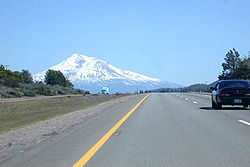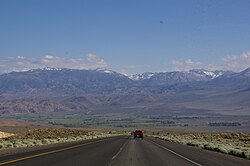Transportation in California
Although known for its car culture and extensive network of freeways and roads, the state also has a vast array of rail, sea, and air transport.
[1] The state's residents typically take to the roads for their commutes, errands, and vacations, giving California's cities a reputation for severe traffic congestion.
[2] These cities, along with Modesto and Visalia, are passed by as I-5 veers west to avoid the congestion of the populated eastern side of the Central Valley as it connects Sacramento and Los Angeles.
State highways in California range from one-lane rural roads to full urban freeways.
However, the state is also currently relinquishing a number of non-freeway segments, especially in urban areas, and turning them over to local control.
Caltrans uses three classes to segregate cycle facilities:[11] Many of the state's local public transportation systems are bicycle accessible.
There is no regular vehicle ferry service to Avalon, however, since the city restricts the use of cars and trucks within its borders.
Because of the state's population growth, many settlements that were once small or rural communities in the 1940s and 50s, when much of California's transportation infrastructure was originally designed, are now thriving suburbs and exurbs.
According to a 2011 study by Forbes, the cities of Lake Elsinore, Los Banos, Adelanto, and Brentwood were ranked as the top four longest commutes in the country.
It would provide a TGV-style high-speed link between the state's four major metropolitan areas, and would allow travel between Los Angeles' Union Station and the San Francisco Transbay Terminal in two hours and forty minutes.
In 2012, the California legislature and Governor Jerry Brown approved construction financing for an initial stage of the project.
The project has been widely described as troubled, being far behind schedule, suffering from management inexperience, and delays in procuring land, and engineering issues.
[19] The transportation problem is beginning to threaten the state's future goals in terms of emissions and carbon neutrality.
[20] As time goes on, however, these goals are becoming increasingly difficult to reach unless the state takes significant measures to combat their transportation problem.
Senate Bill 50, The More Homes Act is waiting to be voted on, and attempts to address the housing crisis by overriding local zoning codes to legalize small apartment buildings (up to 5 stories) in urban areas near jobs and public transportation.
[23] Caltrans plans to work on their infrastructure to make sustainable transportation methods such as trains, biking, and walking more accessible to more people.
Caltrans has acknowledged that extreme wildfires and floods, driven by climate change, have plagued California in recent years which has impacted transportation infrastructure.











